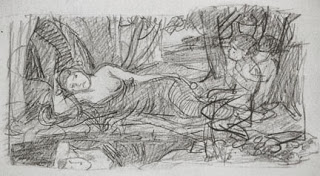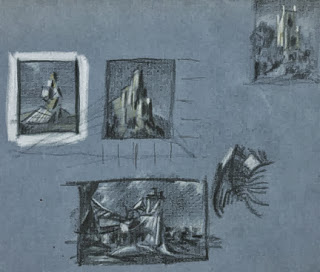One of the best ways to ensure that your final rendering
will have unity and impact is to work it out in a small sketch. If a thumbnail
sketch is interesting, than the final rendering should have a strong presence.
The best artists have been sketching ideas throughout their
careers; working out ideas on a small scale and in a cheap and quick manner. Da
Vinci’s sketch of St. Anne is small
and rough, but starts to suggest the pyramidal composition of the final
masterpiece.
Rubin’s sketch for The
Birth of Henri IV of France is more detailed, but conveys the serpentine composition
clearly.
This sketch for Wolves
Attack by Jozef Chelmonski is a wonderful piece of art in itself, but is also
a roadmap for the execution of a large painting.
J. W. Waterhouse gets an amazing amount of feeling in this
sketch of a Priestess on a Tripod. His
final paintings were often reworked several times on the canvas, so this simple
sketch was just the first impression.
Old Man on his Deathbed
by Gustav Klimt is another sketch that could pass for a finished painting. In
this case it was a study, and not the basis for a larger work.
Simone in a Blue
Bonnet by Mary Cassatt is actually a full sized unfinished portrait, but it
shows all the characteristics of a sketch.
Another sketch by
Waterhouse, Listening to My Sweet Pipings,
presents all the elements of the finished painting without getting involved in
any details.
Architects and Architectural Illustrators also sketch to
develop a strong design for their work. These sketches can range from the size
of a postage stamp to a letter. The medium runs from the simplest pencil doodle
to watercolor.
The Dubai Aquamarina
by Mohammed Bilbeisi is a fascinating conceptual sketch of a proposed
development, suggesting context, trees, people and the hot climate.
Patricia Poundstone’s sketch entitled Fog Ocean Avenue Santa Monica is deceptively simple, while
accurately delineating the atmosphere of the place.
Another evocation of place and time is this watercolor
sketch, Strawbale House Theoretical
by Toshihiro Suwa.
The best advice I can give regarding thumbnail sketching is
to simply do it. The following sketches were done at home, in restaurants and
at parties. They range from 8” x 10” to postage stamp size, and were done with
pencil, felt-tip pen, color pencil and pastel.
Every once in a while a sketch will just turn into an image
that can’t be improved on…
This pastel sketch of a proposed interpretive center has
been a favorite of mine for years, but I have never been able to enlarge it to
my own satisfaction.
A caveat for all posts on composition.
You don’t
want to produce total chaos.
You don’t
want to create banal order.
You do want
to entice, hint, and suggest.
You want to
create mystery, even if the subject appears to be obvious.
- Composition Part 1 - Architectural Illustration
- Composition Part 2 - The Golden Section & other crutches
- Composition Part 3 - Dark Spot
- Composition Part 4 - Light Spot
- Composition Part 5 - The Cross
- Composition Part 6 - The Pyramid
- Composition Part 7 - Circle
- Composition Part 8 - Diagonal
- Composition Part 9 - "L" Frame
- Composition Part 2 - The Golden Section & other crutches
- Composition Part 3 - Dark Spot
- Composition Part 4 - Light Spot
- Composition Part 5 - The Cross
- Composition Part 6 - The Pyramid
- Composition Part 7 - Circle
- Composition Part 8 - Diagonal
- Composition Part 9 - "L" Frame































No comments:
Post a Comment